|
|
Chocolate is many people’s guilty pleasure, but behind the delightful taste lies a complex global industry with a supply chain fraught with moral dilemmas.
The production of mainstream chocolate has, unfortunately, been linked to some deeply concerning practices, including the use of child labor and significant contributions to deforestation.
Amidst these issues, however, a ray of hope shines through in the form of ethical chocolate brands. These trailblazers in the industry are committed to making a difference by adhering to principles of fair trade, sustainability, and transparency throughout their production processes, ensuring that every bite of their chocolate is not only delicious but also socially and environmentally responsible.
In this article, we’ll delve into the world of chocolate, exploring its origin, market, ingredients, production process, and impact. We’ll also identify 11 of the best ethical chocolate brands whose products let you indulge responsibly. Moreover, we’ll discuss the benefits of choosing ethical chocolate over its conventional counterparts, offer tips on supporting ethical chocolate brands, and discuss what you should look for when buying chocolate.
Key Takeaways
-
- Ethical chocolate brands prioritize fair trade, sustainability, and transparency.
-
- Supporting ethical chocolate brands helps combat child labor and deforestation in the cocoa industry.
-
- When buying chocolate, look for certifications such as Fair Trade, Rainforest Alliance, and USDA Organic.
-
- By choosing ethical chocolate, consumers can indulge guilt-free while positively impacting cocoa farmers and the environment.
The Origin of Chocolate
The origin of chocolate is a fascinating story that takes us back thousands of years to where it all began–the ancient civilizations of Mesoamerica. The Aztecs and Mayans were among the first to unlock the potential of the cocoa bean, transforming it into a bitter beverage far from the sweet treat we know today. This drink was not merely consumed for pleasure; it held significant cultural and spiritual importance, often associated with rituals and used as offerings to the gods.
The journey of chocolate from this sacred drink to a beloved global confection is a testament to human innovation and cultural exchange.
Following the arrival of Europeans in the New World, chocolate quickly caught the attention of explorers and settlers. The Spanish, in particular, took a keen interest in this exotic delicacy, adding sugar to counteract its natural bitterness and introducing it to the European palate. From there, chocolate’s popularity blossomed, evolving over centuries into the diverse products enjoyed worldwide today.
Central to the story of chocolate is the cocoa bean itself, harvested from the cacao tree (Theobroma cacao). This tropical plant thrives in the equatorial belt, a narrow band around the Earth that provides the ideal climate for cocoa cultivation.
While West Africa currently dominates global cocoa production, contributing around two-thirds of the world’s supply, Latin America and Southeast Asia also play significant roles. These regions are home to vast cocoa plantations that produce the beans vital to chocolate manufacturing.
Through its long history, chocolate has become deeply embedded in many cultures worldwide, celebrated for its taste and ability to connect people and convey emotions. From heartwarming gifts of chocolate on Valentine’s Day to the ubiquitous presence of chocolate in festive celebrations worldwide, this ancient concoction has transcended its original sacred use to become a universal symbol of love, comfort, and joy.
Global Chocolate Market
Now that we have looked into chocolate’s history, let’s explore this timeless treat’s market.
According to Vantage Market Research, the global chocolate market’s value reached USD 136.76 million in 2022. The ever-growing popularity of this indulgent treat indicates a bright future, as projections suggest the market could swell to USD 193.01 million by 2030. This growth is expected at a compound annual growth rate (CAGR) of 4.40%.
Such statistics reveal chocolate’s enduring appeal and spotlight the industry’s substantial economic impact and potential, underscoring several vital points, including:
-
- Diverse Consumer Base: The steady increase in the market value of chocolate speaks to a global consumer base with varied tastes and preferences. From luxury artisan chocolates to everyday snack bars, the broad spectrum of products available caters to different markets and demographics, driving overall industry growth.
-
- Innovation in the Industry: The chocolate industry has demonstrated remarkable resilience and adaptability, frequently innovating to meet changing consumer demands. This includes the introduction of new flavors, healthier options with lower sugar content, organic and ethically sourced ingredients, and specialty dietary options such as vegan chocolate.
-
- Ethical and Sustainable Growth: As consumers become increasingly conscious of environmental issues and labor practices, demand for sustainably produced and ethically sourced chocolate is growing. This trend towards ethical consumption catalyzes change within the industry, encouraging more brands to adopt fair trade practices and transparent sourcing methods.
-
- Expansion Opportunities: The projected growth offers significant opportunities to expand into new markets and develop niche segments within the chocolate industry. Brands that identify and tap into emerging trends—such as plant-based diets or interest in exotic flavors—can capture a significant market share.
-
- Economic Impact: Beyond consumer pleasure, the chocolate industry is crucial in global economies, providing livelihoods for millions, from cocoa farmers to retail workers. As the market expands, it has the potential to create more jobs and better livelihoods for people involved at every stage of the chocolate production process.
Given its vast market, you might wonder who leads the world in chocolate consumption. According to Statista Market Insights, in 2022, Switzerland led the world in chocolate consumption, with each person consuming an impressive 11.8 kilograms (about 26 pounds) of chocolate over the year. Germany and the United States also stand out for their chocolate consumption. In Germany, each person enjoys about 5.8 kilograms (roughly 12.8 pounds) of chocolate yearly. Meanwhile, Americans consume an impressive average of 9 kilograms (nearly 19.8 pounds) of chocolate per person each year.
On the flip side of chocolate consumption, India and China have much lower rates per person. According to data from Statista, India’s per-capita chocolate consumption is around 1.0 kilogram (about 2.2 pounds) annually. It’s even less in China, at just 0.2 kilograms (approximately 0.44 pounds) per person each year.
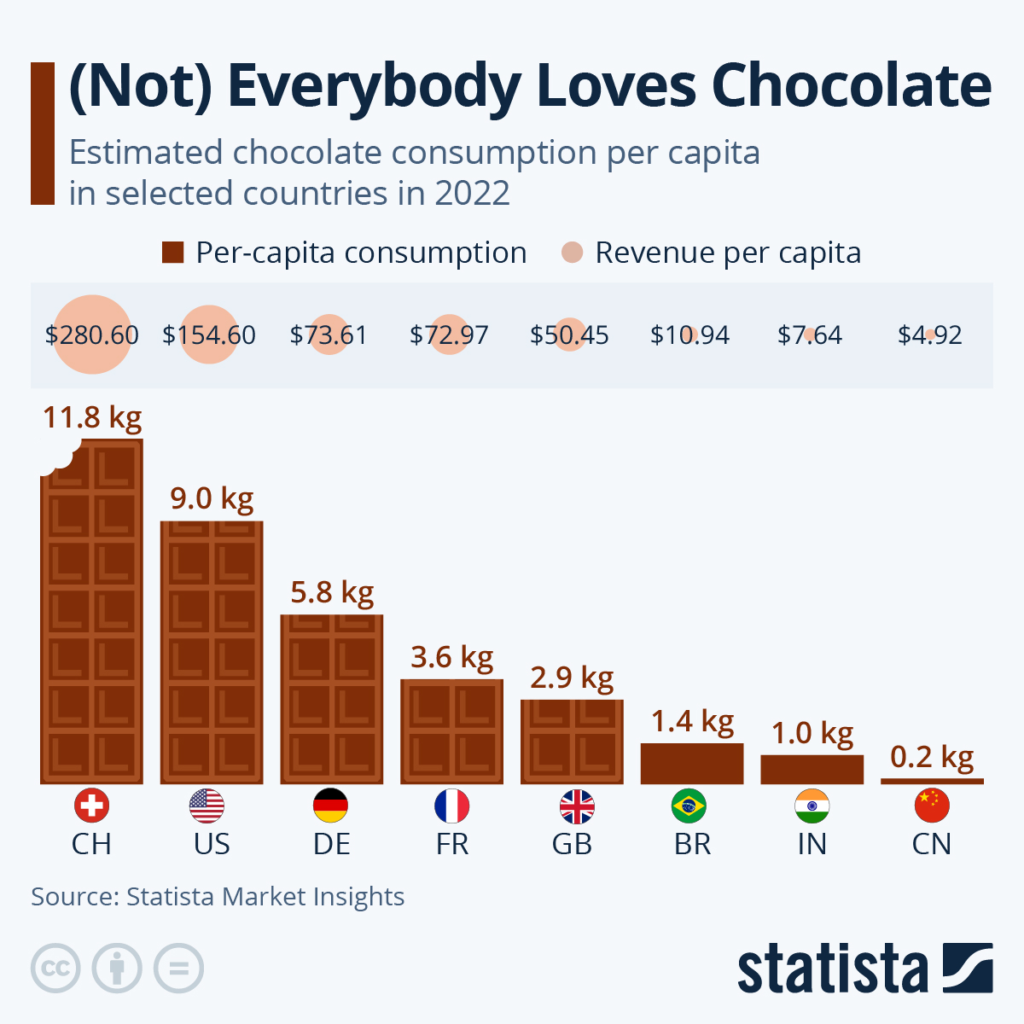
Image Source: https://www.statista.com/chart/3668/the-worlds-biggest-chocolate-consumers/
What is Chocolate Made Of?
As chocolate continues to captivate tastebuds worldwide, it’s good to know what gives it its signature allure.
At its heart, chocolate is a blend of essential ingredients, each contributing to its irresistible flavor, texture, and aroma. Let’s delve into the components that give chocolate its distinctive taste.
-
- Cocoa Beans: The cornerstone of chocolate production, cocoa beans are the seeds of the cacao tree. These beans are harvested from cocoa pods, indigenous to equatorial regions such as West Africa, Latin America, and Southeast Asia. Rich in cocoa solids and cocoa butter, cocoa beans impart the distinct chocolatey taste and velvety texture that define premium chocolate products.
-
- Cocoa Butter: Extracted from cocoa beans during chocolate-making, cocoa butter is a natural fat prized for its smoothness and mouthfeel. This luxurious ingredient lends chocolate its melt-in-your-mouth quality and glossy finish. Cocoa butter also plays a crucial role in tempering, ensuring the chocolate sets appropriately and maintains its shape at room temperature.
-
- Sugar: Sugar is added to chocolate formulations to balance the bitterness of cocoa. This sweetener enhances the flavor profile and contributes to the smoothness and creaminess of the chocolate. Depending on the desired sweetness level, different types of sugar, such as cane sugar or confectioner’s sugar, may be used in chocolate production.
-
- Milk: In the case of milk chocolate, milk solids or milk powder are incorporated into the chocolate mixture. This addition imparts a creamy, dairy-rich flavor to the chocolate, making it a favorite among connoisseurs of indulgent treats. Milk chocolate is celebrated for its luscious mouthfeel and subtle sweetness, making it a beloved choice for chocolate lovers of all ages.
-
- Flavorings and Additives: Chocolatiers often incorporate flavorings and additives into their formulations to create diverse chocolate varieties. For added depth and complexity, these may include natural extracts such as vanilla or spices like cinnamon and chili. Additionally, inclusions such as nuts, fruits, or caramel are often mixed into the chocolate to create tantalizing texture contrasts and flavor combinations.
-
- Emulsifiers and Stabilizers: Emulsifiers such as lecithin are commonly added to chocolate to facilitate the blending of ingredients and prevent the separation of cocoa solids and cocoa butter. Stabilizers may also be used to improve the viscosity and shelf stability of the chocolate, ensuring a smooth and consistent product.
By combining these essential ingredients in precise proportions, chocolatiers work their magic to produce indulgent chocolates that captivate the senses and uplift the spirit, from velvety milk chocolate bars to intense dark chocolates.
Chocolate Production: From Bean to Bar
Turning cocoa beans into chocolate is a meticulous and multi-step process, encompassing farming and cultivation, fermentation, roasting, grinding and conching, tempering, and shaping. Each stage plays a pivotal role in shaping the final product’s flavor, texture, and quality.
-
- Farming and Cultivation: The process begins with diligently cultivating cocoa trees in tropical regions, where favorable climates and fertile soils foster optimal growth. Cocoa farmers meticulously tend to their crops, nurturing the delicate cocoa pods until they ripen to perfection. Sustainable and ethical practices are paramount at this stage, ensuring fair treatment of farmers and preservation of the environment.
- Fermentation: Once harvested, the cocoa pods are cracked open to reveal the precious cocoa beans nestled within. These beans undergo a crucial fermentation process, typically lasting several days, during which natural sugars in the beans are converted into acids, unlocking the complex flavors characteristic of fine chocolate. Proper fermentation is essential for developing the nuanced flavor profiles that distinguish high-quality chocolate.
- Roasting: After fermentation, the cocoa beans are carefully roasted to enhance their flavor and aroma. Roasting temperatures and durations vary depending on desired characteristics, with factors such as bean origin and desired chocolate intensity influencing the process. Roasting also helps remove residual moisture from the beans, ensuring optimal grinding and flavor development.
- Grinding and Conching: Once roasted, the cocoa beans are finely ground into a thick, viscous paste known as chocolate liquor. This intense grinding process releases the natural fats, or cocoa butter, in the beans, contributing to chocolate’s smooth texture and luscious mouthfeel. The chocolate liquor may undergo a second round of grinding called conching, further refining its consistency, flavor, and texture.
- Tempering: The final step in the chocolate-making process is tempering, a precise technique that carefully controls the chocolate’s temperature as it cools. Proper tempering ensures that the cocoa butter in the chocolate crystallizes into stable crystals, resulting in a glossy finish, satisfying snap, and smooth texture. Tempering also prevents the formation of undesirable fat blooms and ensures that the chocolate retains its quality and shelf life.
- Shaping: After the meticulous tempering process, the chocolate undergoes a final transformation: shaping. This step adds the finishing touch to the chocolate production process, giving it its recognizable form, whether the classic rectangular bar, elegant truffles, or intricately designed bonbons.

Image Source: https://www.researchgate.net/publication/318461240_Research_Journal_of_Pharmaceutical_Biological_and_Chemical_Sciences_Influence_of_hydrocolloids_in_chocolate_confections_A_review/
Impact of Chocolate Production
As we savor chocolate’s rich flavors and textures, it’s crucial to acknowledge and address the challenges within its supply chain.
The surge in global demand for chocolate has placed immense pressure on cocoa-producing regions, often leading to environmental degradation through deforestation and biodiversity loss.
The Washington Post has highlighted a pressing environmental issue: significant deforestation in West Africa, a leading cocoa-producing region. Ivory Coast and Ghana are of particular concern. Over the last five decades, Ivory Coast has drastically reduced its forests, losing about 80% of them. Similarly, in Ghana, deforestation has cleared land equivalent to the size of New Jersey.
While illegal mining contributes to this forest loss, a substantial part of the deforestation is due to the actions of numerous cocoa farmers. Many farmers struggling with poverty cut down mature trees to increase their farming land. The cutting often occurs within national parks and protected forests, areas meant to preserve biodiversity and natural resources.
The consequences of removing these trees extend beyond the loss of forest cover. When trees are left to decay, they no longer absorb carbon dioxide from the atmosphere. Instead, they release it, contributing to climate change.
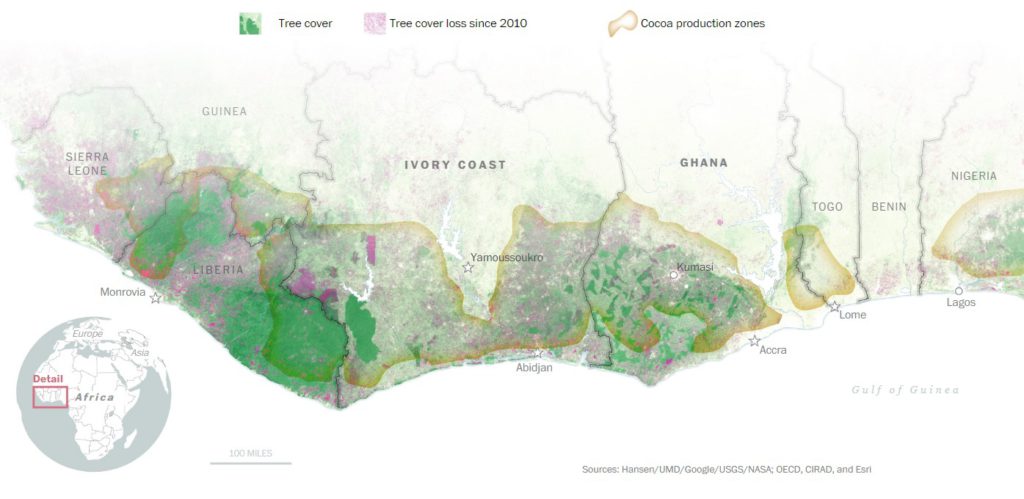
Image Source: https://www.washingtonpost.com/graphics/2019/national/climate-environment/mars-chocolate-deforestation-climate-change-west-africa/
Moreover, the industry has been scrutinized for social issues such as unfair labor practices, including inadequate compensation for cocoa farmers and child labor.
The Guardian sheds light on cocoa farmers’ harsh realities, particularly in areas essential for global cocoa production, such as Ivory Coast. These farmers earn less than a dollar a day on average, an income that underscores the profound poverty many of them face. Their working conditions are far from easy, toiling under the scorching sun, often without shade, and handling dangerous pesticides that pose serious health risks.
When it comes to the economics of the chocolate industry, the disparity is stark. Cocoa growers receive only 6% of the final sale price of a chocolate bar. In contrast, manufacturers and retailers claim about 80% of the profits.
Child labor is another significant ethical issue plaguing the chocolate industry. The US Department of Labor estimates that 1.56 million children are involved in child labor across cocoa farms in Côte d’Ivoire and Ghana. These two countries are at the center of global cocoa production, contributing to nearly 60% of the world’s cocoa annually.
In these areas, children are often found working on cocoa farms under conditions that can be described as harsh and exploitative. 43% of these children are involved in various tasks, from planting and harvesting cocoa beans to hazardous activities like carrying heavy loads, burning fields, and using dangerous tools.

Image Source: https://www.dol.gov/agencies/ilab/our-work/child-forced-labor-trafficking/child-labor-cocoa
11 Ethical Chocolate Brands to Check Out
The challenges in the chocolate industry mentioned above require urgent attention and action from all stakeholders involved in cocoa production and chocolate manufacturing. They are also prompting a growing movement towards ethical chocolate production.
Ethical chocolate brands prioritize fair trade practices, ensuring that farmers receive a fair wage and work in safe conditions. They also focus on sustainability, adopting agroforestry practices that integrate cocoa cultivation with the conservation of ecosystems.
By choosing chocolate from ethical brands, consumers can indulge responsibly, supporting efforts to improve the lives of cocoa farmers and protect the environment. Below are 11 ethical chocolate brands that prioritize these commendable practices:
1. Divine Chocolate

Founded in 1998, Divine Chocolate distinguishes itself through its unique ownership structure—it’s co-owned by the women-led Kuapa Kokoo Farmers’ Union. This Ghanaian cooperative encompasses over 100,000 cocoa farmers, over a third of whom are women, representing a powerful movement for equitable trade in the cocoa industry. This partnership ensures that these farmers are not merely suppliers but integral stakeholders who receive fair prices for their crops and a share in the company’s profits. It also empowers women in the cocoa farming industry, helping them develop the skills and confidence to cultivate better cocoa.
Divine Chocolate offers a broad selection of products that cater to various tastes and preferences. Their offerings include Fair Trade Certified chocolate bars, indulgent truffles, generously sized sharing bars perfect for families and gatherings, and an array of vegan options to ensure everyone can enjoy the richness of quality chocolate. Beyond bars, Divine elevates the home baking and hot chocolate experience with their ethical cocoa powder—made from 100% unsweetened cocoa and processed with alkali to achieve the perfect balance of flavor.
A commitment to sustainability and ethical practices runs deep at Divine Chocolate. Their entire range is palm oil-free, aligning with global efforts to combat deforestation and protect ecosystems. It’s also vegetarian-friendly, making it accessible to a broad audience. For those who prioritize organic products, Divine Chocolate’s certified organic range is sourced from a farmer cooperative in São Tomé, showcasing their dedication to supporting sustainable farming communities across the globe.
Packaging is another aspect where Divine shines. The brand is steadfast in its commitment to environmental responsibility, using only recycled or recyclable materials for its packaging. This approach reduces waste and encourages consumers to make eco-friendly choices.
2. Tony’s Chocolonely
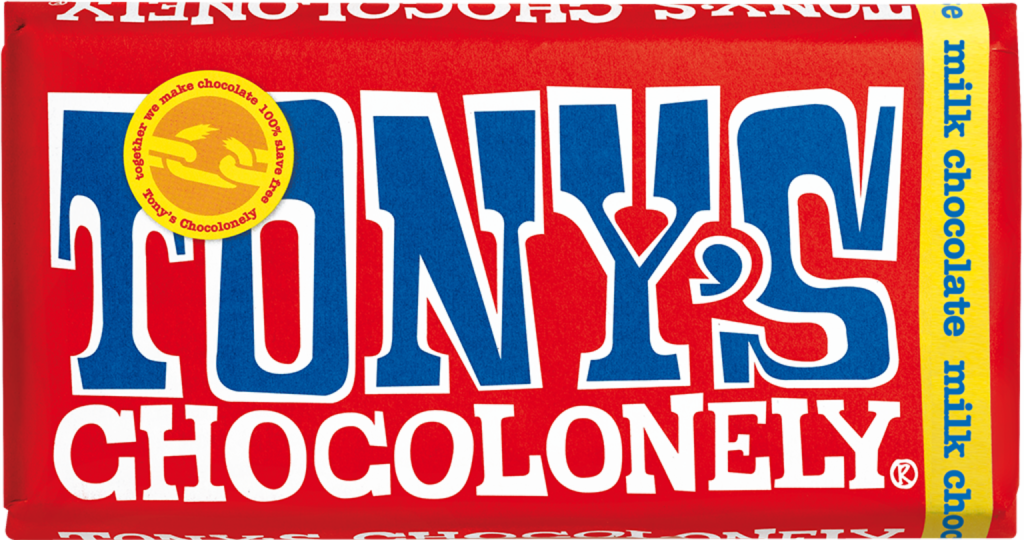
With a solid mission to eradicate child labor and slavery from the chocolate industry, Tony’s Chocolonely is more than just a chocolate brand; it’s an activist movement. It champions three critical pillars toward achieving 100% slave-free chocolate: raising awareness, leading by example, and inspiring action.
Integral to its mission is Tony’s Open Chain initiative, a bold step towards inviting more companies to join the fight against slavery and illegal child labor in the cocoa sector. This initiative highlights the industry’s human rights and sustainability challenges, providing a clear, actionable framework for adopting fair cocoa sourcing practices. It rests on Tony’s 5 Sourcing Principles: ensuring 100% traceability of cocoa beans, offering fair compensation above market prices, empowering farmers through cooperative strengthening, establishing long-term direct partnerships, and enhancing cocoa quality and productivity for better yields.
Tony’s Chocolonely offers chocolate lovers indulgence and an opportunity to contribute to a noble cause. Their chocolate bars boast distinctive bold flavors housed in eye-catching packaging—making each bar an exciting, purpose-driven treat. The brand’s signature 180g bars, with their unevenly sized chunks, serve as a delicious reminder of the unequal profit distribution in the chocolate industry. This creative approach underscores Tony’s commitment to equity and fairness, echoing their core message with every bite.
3. Alter Eco
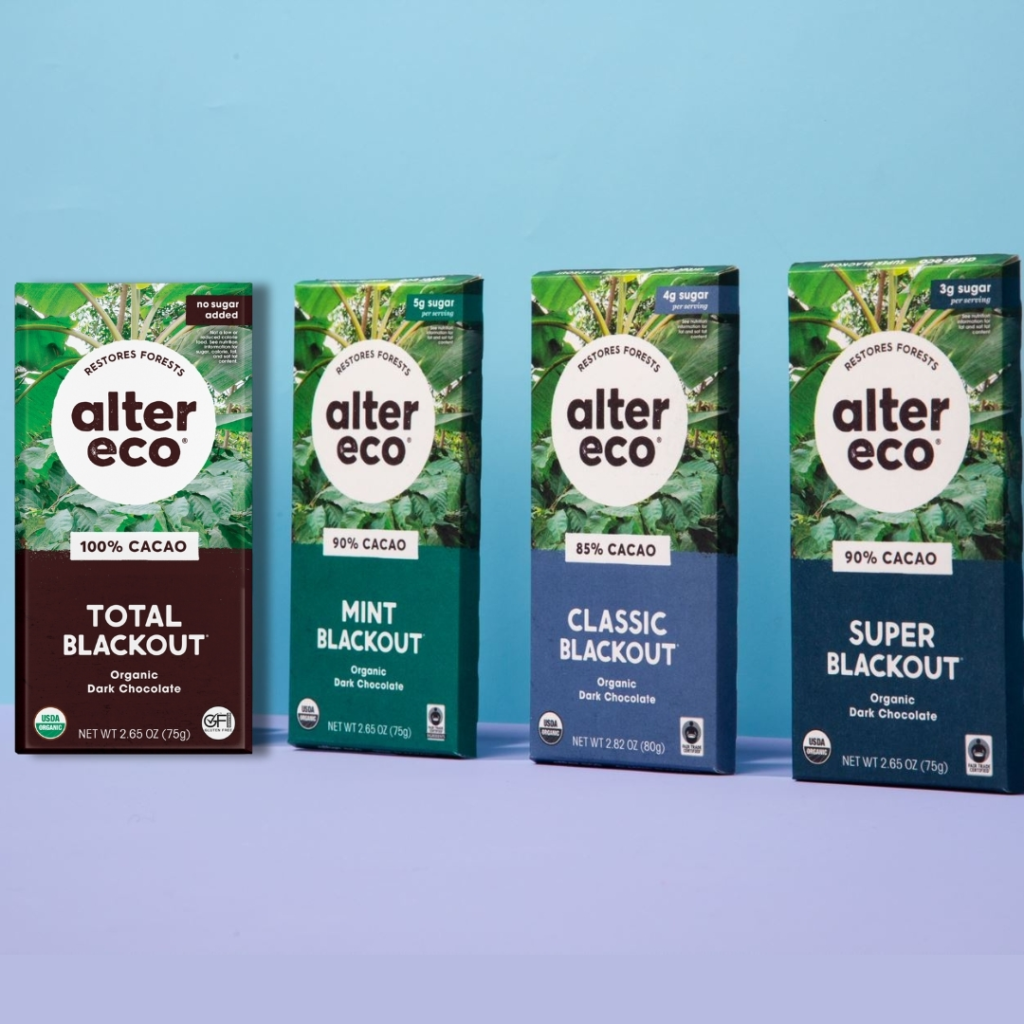
Alter Eco is a B Corp certified company committed to high social and environmental impact standards. The brand undertakes a vital mission in helping its farmers embrace dynamic agroforestry—a method of regenerative agriculture that enhances their livelihoods and plays a significant role in combating climate change.
This commitment extends to how Alter Eco sources its ingredients, prioritizing fair trade to ensure ethical practices across the supply chain. Their chocolate bar selection caters to various tastes, from silky smooth milk chocolates to rich, intense dark varieties, providing a sustainable option for every chocolate enthusiast. Additionally, Alter Eco’s dedication to organic products means consumers can enjoy treats free from GMOs, additives, gluten, and soy—making it a win for health-conscious individuals.
Packaging is another area where Alter Eco stands out. Emphasizing environmental responsibility, all packaging is compostable, recyclable, or made from post-consumer recycled materials. This focus on sustainability helps reduce waste and supports the brand’s eco-friendly ethos.
The Sea Salt Truffles from Alter Eco has garnered acclaim for their exquisite taste, perfectly balancing the slight bitterness of dark chocolate with sweet notes of caramel for a truly indulgent experience. The brand’s range of chocolate bars also impresses with its impeccable quality—each bar delivers a smooth texture, freshness, and just the right level of sweetness to satisfy any craving.
4. Endangered Species Chocolate
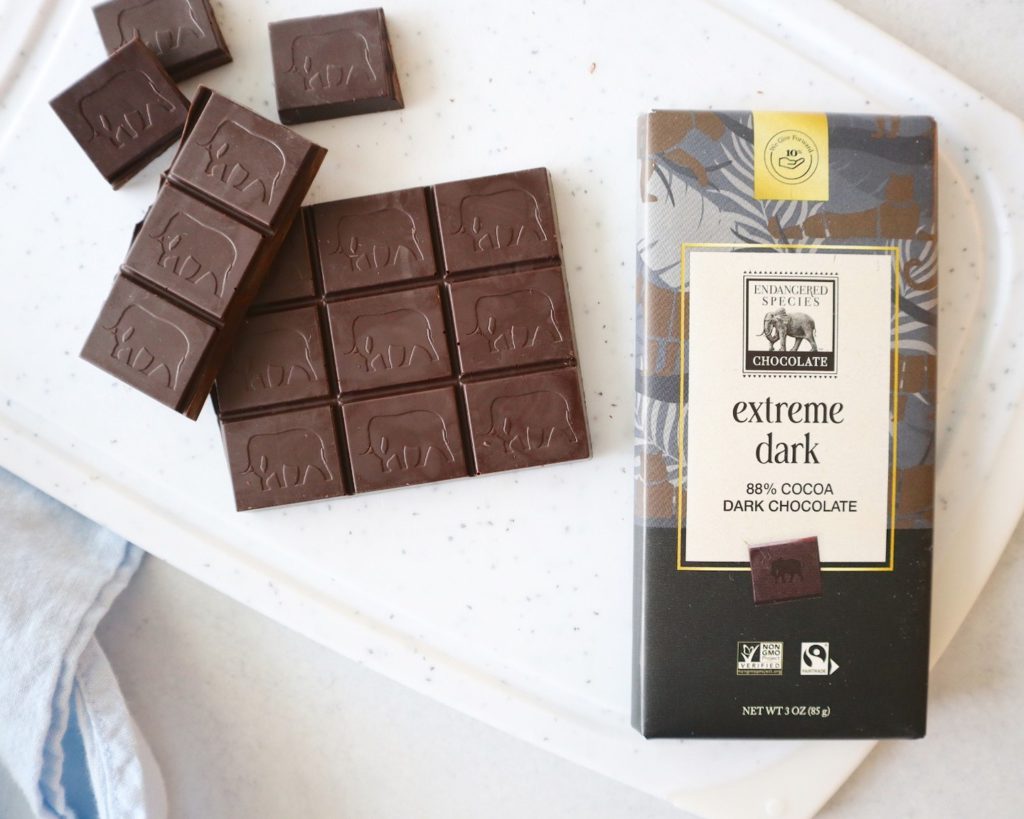
Dedicated to wildlife protection and conservation, Endangered Species Chocolate has been crafting premium chocolate for three decades. The brand combines ethical sourcing with a mission to support endangered animals and their habitats.
Since 2016, Endangered Species Chocolate has made significant financial contributions, surpassing $3,100,000, to various impactful organizations and initiatives. By donating 10% of its net profits, the brand plays a vital role in efforts aimed at preserving diverse species, their natural environments, and, by extension, humanity itself.
The conscientious approach of Endangered Species Chocolate extends to its ingredients and product offerings. Each bar is crafted using a minimal yet high-quality selection of fair trade ingredients, ensuring no artificial flavors find their way into these treats. This makes them ideal for those seeking sustainable, vegan, kosher, and gluten-free chocolate options. The brand’s flair for unique flavors adds to its appeal, with enticing combinations such as dark chocolate with raspberry filling, orange dark chocolate, fudgy peanut butter milk chocolate, and cinnamon, cayenne, and cherries dark chocolate offering a delightful taste adventure.
For baking enthusiasts or anyone looking to add a touch of luxury to their homemade treats, Endangered Species Chocolate also offers baking chips. These chips follow the brand’s strict guidelines for quality and ethical sourcing, ensuring that even your baked goods can contribute to meaningful conservation efforts.
Your Weekly Sustainability News!
By subscribing you agree to our Privacy Policy
5. Green & Black’s

Green & Black’s roots stretch back to London in 1991 when the vision of founders Craig Sams and Jo Fairley brought to life a chocolate brand that prioritizes nature’s path to great taste. Green & Black’s has carved a niche in premium chocolates by embracing the essence of high-quality organic ingredients through its dedication to ethically sourced cocoa and sustainable practices.
The brand’s commitment to natural processes and superior ingredients is evident in its meticulous methods. Cocoa beans and whole torn Madagascan vanilla pods are sun-dried, a technique to maximize their flavors. Even the brand’s flaked sea salt, used to enhance some of its chocolate bars, is carefully hand-harvested from the coasts of Anglesey, ensuring purity and taste. Similarly, Green & Black’s waits for the last harvest to collect almonds and hazelnuts, guaranteeing their chocolates are filled with only the freshest, crunchiest nuts.
Green & Black’s Maya Gold, inspired by an ancient Mayan recipe of cocoa spiced with flavors from Belize, achieved a significant milestone as the first chocolate bar in the UK to receive the coveted Fairtrade mark. This certification by the Fairtrade Foundation underscores Green & Black’s relentless pursuit of fairness, quality, and sustainability.
Green & Black’s offers a rich spectrum of flavors that appeal to a wide range of chocolate lovers. From luxuriously creamy milk chocolate to the bold intensity of dark chocolate with sea salt, each bar promises a unique experience.
6. Equal Exchange

Equal Exchange operates under a worker-owned cooperative model that deeply values fairness and transparency. This commitment is vividly reflected in their dedication to sourcing fair trade and organic ingredients, ensuring that every product supports equitable trading conditions and sustainable farming methods.
Their chocolate bars are a testament to the power of simplicity and quality. Equal Exchange collaborates with small-scale farmers across the globe, bringing consumers closer to the source of their food while uplifting communities involved in agriculture. This partnership not only ensures the welfare of the farmers but also contributes to the rich taste and superior quality of their chocolates.
For those who appreciate the bold and intense flavors, Equal Exchange’s Very Dark Chocolate Bar has a high cocoa content, delivering a profound cacao experience with just the right amount of bitterness balanced by underlying sweet notes. Its Milk Chocolate with a Hint of Hazelnut is perfect for nut lovers, as this creamy milk chocolate bar is infused with pieces of hazelnut, offering a satisfying crunch and a harmonious blend of flavors. The brand’s Caramel Crunch with Sea Salt Dark Chocolate is an excellent pick for a perfect marriage of sweet and salty. This bar features bits of caramel crunch enveloped in silky dark chocolate, finished with a sprinkle of sea salt for an elevated taste sensation.
7. Loving Earth
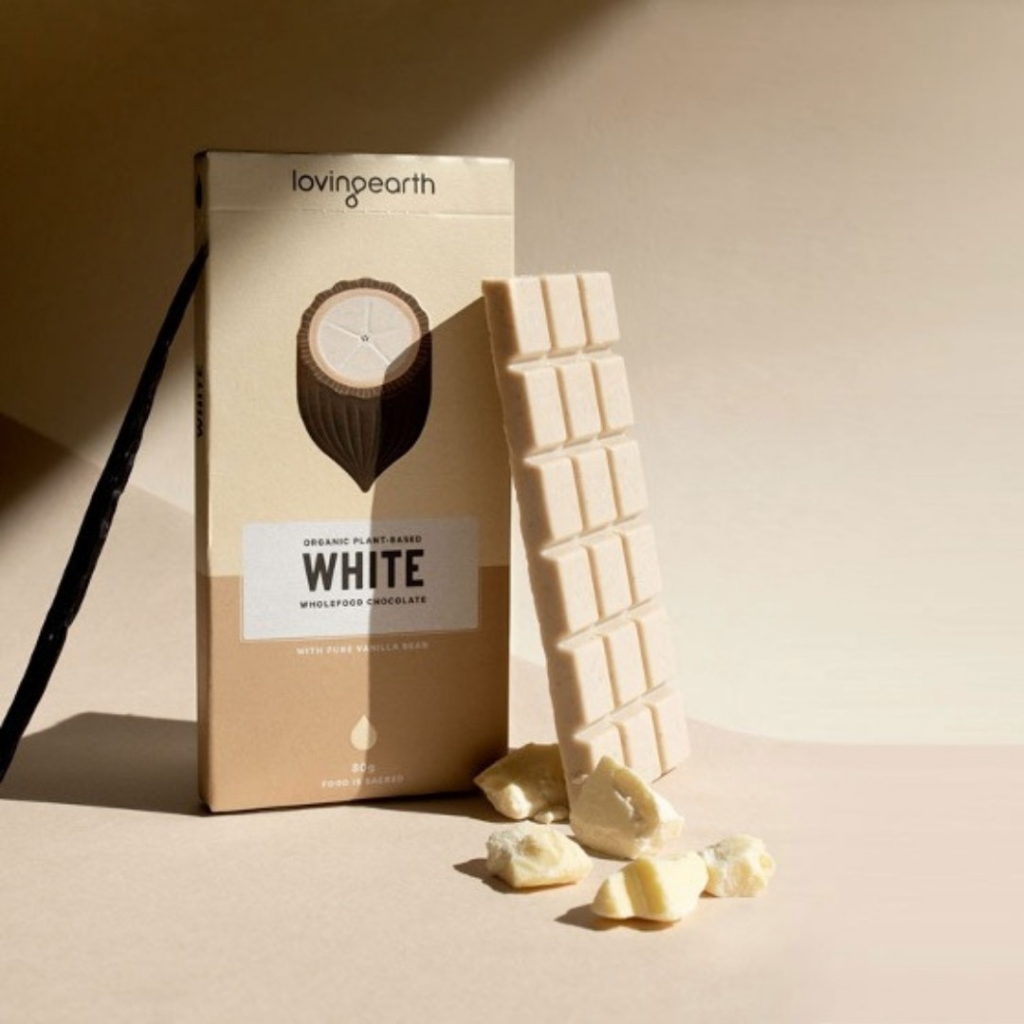
Loving Earth, an Australian trailblazer in the chocolate industry, has meticulously carved out a niche with its artisanal chocolate bars. These delicacies are crafted from raw cacao and coconut sugar, among other ingredients, through ethical channels that ensure fair compensation and respectful treatment of farmers and their lands.
The brand’s holistic approach to sustainability is evident in its dedication to regenerative farming practices. By supporting methods that replenish and rejuvenate the soil and natural ecosystems, Loving Earth contributes to the planet’s health, ensuring that agriculture harmoniously coexists with nature. This commitment aids in preserving biodiversity, enhancing ecosystem services, and combating climate change, making every Loving Earth product part of a solution to environmental challenges.
A partnership model that emphasizes direct collaboration with small-scale farms and indigenous groups is at the heart of its operations. By working closely with these communities, Loving Earth ensures they are fairly compensated, supporting their economic stability and growth.
For those seeking dairy alternatives, Loving Earth’s Creamy Coconut Mylk Chocolate is a dairy-free delight that uses coconut nectar and cashews to replicate milk chocolate’s creamy texture and sweet flavor. For those looking for something a bit decadent without the guilt, the Hazelnut Mylk Chocolate bar delivers a luxurious nutty flavor balanced with just the right sweetness from coconut sugar.
8. The Raw Chocolate Co.

The Raw Chocolate Company is a UK-based chocolate brand that delights with its innovative flavors and health-conscious products, including chocolate-covered fruits and nuts.
What sets The Raw Chocolate Co. apart is its dedication to crafting chocolates that retain the natural goodness of cacao. By specializing in raw chocolates, they ensure that their products maintain the highest levels of antioxidants and nutritional benefits, all while delivering exquisite taste profiles. This approach aligns perfectly with consumers’ growing demand for foods that support their health without compromising flavor.
The Raw Chocolate Co. exemplifies environmental stewardship and social responsibility through its cacao sourcing practices, particularly its commendable initiatives in Peru. In the verdant surroundings of the Rio Abiseo National Park, located in the San Martin region, the company has forged a purposeful partnership with the National Gamekeepers Organisation and Amazonia Viva Project. This collaboration is part of a broader commitment to preserve the precious ecosystem and to support the indigenous communities that depend on it.
Moreover, The Raw Chocolate Co. has taken an active role in combating deforestation, partnering with Cacao Suppliers Sierra Organics on a tree planting project to foster agroforestry. This initiative not only combats the adverse effects of deforestation but also promotes sustainable agricultural practices among cacao farmers in the region.
9. Taza Chocolate

Deeply inspired by the age-old rich tradition of Mexican stone-ground chocolate, Taza Chocolate offers an authentic taste experience that’s both unique and intensely flavorful.
Founded on ethical sourcing and sustainability principles, Taza has established itself as a trailblazer in the chocolate industry, notable for its Direct Trade certification. This commitment takes fair trade a step further, ensuring fair prices and fostering direct, transparent relationships with cocoa farmers.
Moreover, Taza Chocolate leads with transparency in its operations, publishing an annual report detailing prices paid for cocoa, quantities purchased, and insights into its relationship with farmer partners. This level of openness builds trust and accountability, setting a standard in the industry.
One of the defining aspects of Taza’s chocolate bars is their unique texture. Embracing traditional Mexican stone mills called molinos, Taza crafts chocolate with a distinctive gritty, less processed feel. This method pays homage to a rich cultural heritage and intensifies the cocoa’s natural flavors, offering a pure, unadulterated chocolate experience.
Taza’s offerings cater to a broad spectrum of palates, from intense dark to innovatively flavored bars. Options like the spicy Cinnamon Chili bar or the subtly sweet Vanilla feature simple, high-quality ingredients that let the natural taste of the cocoa shine through.
10. Raaka Chocolate
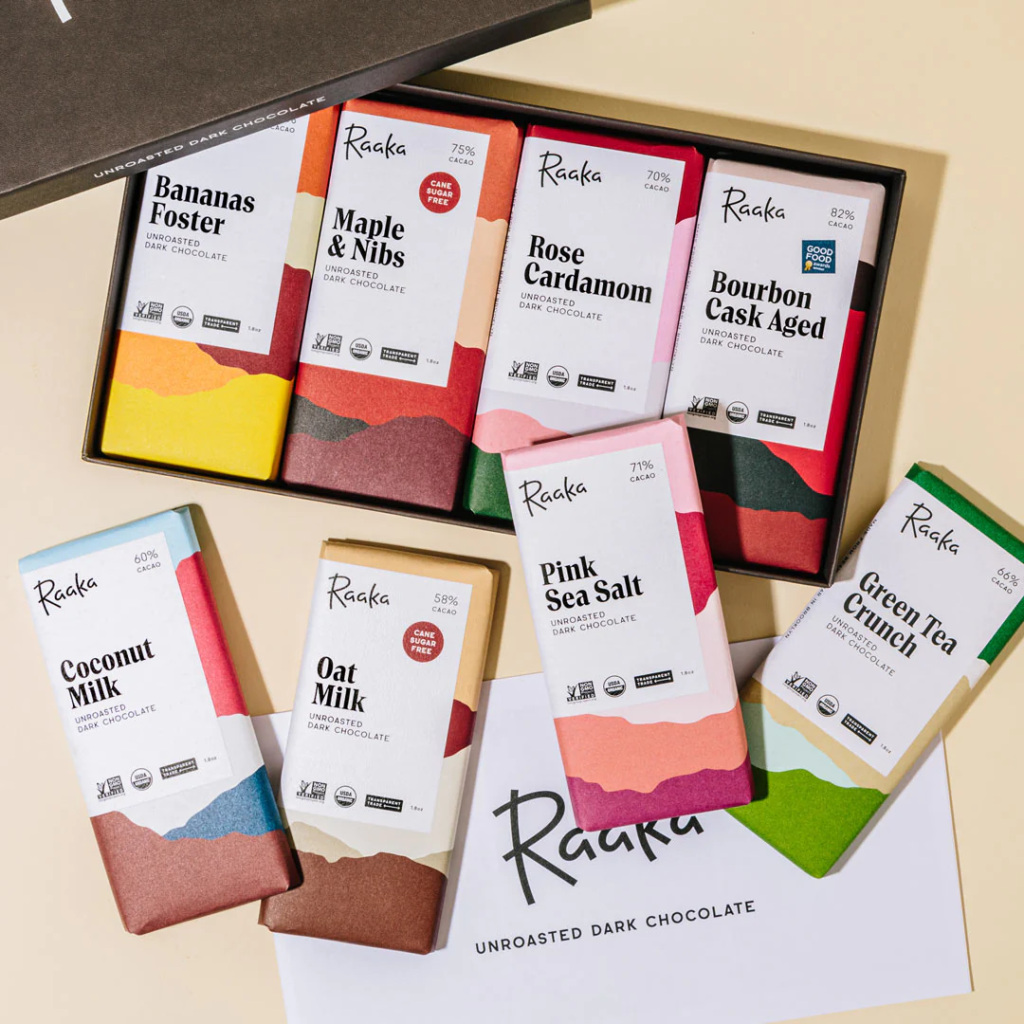
Raaka Chocolate distinguishes itself through its innovative use of unroasted cocoa beans. This unique method allows Raaka to produce chocolate bars that encapsulate the cacao bean’s most vibrant and natural flavors, offering an unparalleled taste experience that’s as raw and authentic as it gets.
Each bar crafted by Raaka is a testament to its commitment to flavor, ethical practices, and sustainability. The brand provides detailed information about where its cocoa comes from, how it’s sourced, and why it chooses specific beans. Raaka also publishes transparent trade reports that outline its sourcing practices, including the price paid for cocoa, volumes purchased, and the impact of its direct trade relationships.
Moreover, Raaka directly trades with cocoa producers, ensuring it pays a premium above the market rate directly to the farmers. This approach fosters a closer relationship with suppliers and supports sustainable farming practices by providing farmers with a livable income.
Raaka is renowned for its creative and adventurous flavor combinations. From Pink Sea Salt to Bourbon Cask Aged, its bars incorporate elements that excite and challenge the palate. The brand also offers limited batch editions monthly, featuring seasonal ingredients and innovative blends that reflect Raaka’s experimental spirit.
11. Beyond Good

Beyond Good, formerly Madécasse, stands out in the chocolate industry for its single-origin chocolate bars and its profound impact on Madagascar, where it sources its cocoa. The company goes beyond the usual practices of fair trade and sustainability; it deeply immerses itself in improving local cocoa farming communities and promoting economic development within the region.
By working directly with cocoa farmers in Madagascar, Beyond Good plays a pivotal role in improving livelihoods. It provides farmers with higher incomes through fair trade practices, a significant step towards alleviating poverty and encouraging sustainable cocoa farming practices in the region.
It extends its support beyond financial means by offering training and educational programs to farmers. These initiatives aim to enhance agricultural techniques, increase yields, and improve the quality of cocoa, ensuring that the benefits ripple through to future generations.
Beyond Good’s commitment to producing single-origin chocolates allows it to highlight and celebrate the unique, rich flavors and characteristics inherent to Madagascar’s cocoa. Each bar tells a story of its origin, offering chocolate lovers a pure taste experience that can’t be found elsewhere.
The brand’s range showcases the diverse palette of Madagascar’s cocoa, from subtle hints of red fruit to deep notes of cocoa. Its selection includes everything from smooth and creamy to intensely dark chocolates, bringing chocolate lovers closer to the essence of the products’ source through exquisite flavor profiles.
Beyond traditional chocolate bars, Beyond Good explores innovative confections and offerings that further showcase the versatility of Madagascar’s cocoa. From cocoa nibs perfect for culinary uses to creatively flavored bars that incorporate Madagascar’s vanilla or rare spices, the brand invites consumers to explore a broader spectrum of chocolate experiences.
Why Choose Ethical Chocolate Brands?
Choosing ethical chocolate brands exemplifies a conscious decision that benefits your taste buds and the world. Here’s why opting for these brands makes a significant difference:
-
- Supporting Cocoa Farmers: Ethical chocolate brands pay fair prices to cocoa farmers, helping them earn a living income and improve their quality of life.
-
- Promoting Sustainability: These brands help protect the environment and preserve biodiversity by prioritizing sustainable farming practices and ethical sourcing.
-
- Combatting Child Labor: Ethical chocolate brands work to eradicate child labor and promote education and community development in cocoa-growing regions.
-
- Ensuring Quality and Transparency: With transparent supply chains and high-quality ingredients, ethical chocolate brands offer consumers peace of mind and a truly satisfying chocolate experience.
How to Support Ethical Chocolate Brands
Supporting ethical chocolate brands is a powerful way to positively impact the environment, human rights, and quality of the products we enjoy. Here’s how you can lend your support to these commendable efforts:
-
- Educate Yourself and Others: Dive deeper into where and how your favorite chocolates are made. Understanding the journey from cocoa bean to chocolate bar can reveal a lot about a brand’s values. Share these insights with friends, family, and your online community to spread awareness.
-
- Look for Certifications: Certifications like Fair Trade, Rainforest Alliance, or Organic are more than just labels on packaging—they’re signals of a brand’s dedication to ethical practices. These certifications indicate adherence to standards that benefit both people and the planet.
-
- Choose Quality Over Quantity: Ethically produced chocolate might come at a higher price, but this reflects the actual cost of ensuring sustainable agriculture and fair compensation for workers. Investing in higher-quality chocolate not only treats you to a richer experience but also supports critical ethical efforts.
-
- Engage with Brands: Reach out and connect with chocolate brands that prioritize transparency. Many such companies are keen to share their stories and practices through social media or websites. This engagement strengthens your understanding and encourages brands to maintain high ethical standards.
-
- Spread the Word: Your recommendations have power. By advocating for ethical chocolate brands to those around you and requesting these products in local stores, you contribute to a growing demand for responsibly produced chocolate. Using platforms like social media to highlight ethical choices can influence others and amplify the message.
What to Look for When Buying Chocolate
When selecting chocolate, making an informed choice can contribute to more ethical and sustainable consumption. Here are essential aspects to ensure your chocolate indulgence supports positive practices:
-
- Certifications: Seek out the certifying labels that matter. Certifications such as Fair Trade, Rainforest Alliance, and USDA Organic are not just badges—they assure that the product meets rigorous standards for ethical labor practices and environmental sustainability.
-
- Transparent Sourcing: Transparency is vital in ethical chocolate production. Look for brands that openly share details about where their cocoa comes from. This includes information on the origins of the beans, the conditions under which they were farmed, and how the brand engages with and supports its cocoa farmers.
-
- Ingredients: The list of ingredients can tell you a lot about the quality of the chocolate and the brand’s commitment to sustainability. Favor chocolates that use a few high-quality, whole ingredients. Be cautious of those containing palm oil, which is often linked to deforestation and habitat destruction, or unnecessary artificial additives.
-
- Packaging: Packaging reflects a brand’s commitment to the environment. Opt for chocolates wrapped in eco-friendly materials or brands with initiatives to reduce waste. This can mean opting for chocolates wrapped in recyclable or compostable materials or brands actively working towards reducing their packaging footprint.
Conclusion
In today’s chocolate market, fraught with challenges like child labor and rampant deforestation, choosing ethical chocolate brands has never been more critical.
By supporting companies that prioritize fair trade, sustainability, and transparency, consumers can enjoy their favorite treat with a clear conscience.
From Divine Chocolate and Tony’s Chocolonely, the 11 ethical chocolate brands presented above offer a wide array of tempting options for those mindful of the impact of our indulgences. Whether you’re drawn to the rich, deep flavors of dark chocolate or prefer the creamy delights of milk chocolate, there’s an ethical option for you. By supporting these responsible businesses, your chocolate experience becomes a moment of personal pleasure and an act of global significance.
Frequently Asked Questions
What does fair trade chocolate mean?
Fair trade chocolate means that the cocoa beans used to make the chocolate are sourced ethically, ensuring fair treatment and payment to the farmers and workers involved in the production process.
Are there any vegan chocolate options among ethical chocolate brands?
Yes, there are several ethical chocolate brands that offer vegan chocolate options made without any animal products or by-products.
How can I identify fair trade chocolate brands?
Look for certifications such as Fair Trade Certified or Fair for Life labels on the packaging to identify fair trade chocolate brands that adhere to ethical sourcing and production practices.
Is organic chocolate considered to be ethical?
Yes, organic chocolate is often considered ethical as it is produced without the use of synthetic pesticides and fertilizers, promoting environmental sustainability and the well-being of cocoa farmers.
What is the significance of a slave-free label on chocolate products?
A slave-free label indicates that the chocolate has been produced without the use of forced or child labor, offering consumers assurance of ethical practices in the chocolate supply chain.
How can I ensure that the chocolate I purchase is sourced sustainably and ethically?
Look for information on the brand’s cocoa sourcing policy and certifications, such as Fair Trade or Rainforest Alliance, ensuring that the chocolate is sourced sustainably and ethically.












